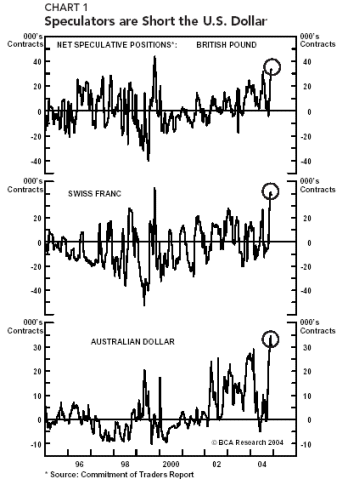This Is The Next Area of Concern for FX Traders
Intervention Fears–The
Next Area of Concern for FX Traders
Rhetoric aside,
there is a genuine possibility that intervention in the FX markets is a real
possibility. The dollar’s broad based decline is frustrating many central
banks, the ECB being the most vocal recently, in addition to the BoJ and to
a lesser extent the RBZ (Australia) and SNB (Switzerland). With thin
December markets nearing, and no meaningful move higher in the dollar, the
time is ripe for a coordinated intervention.Â
Historically
speaking, the EUR/USD at current levels does still not represent a similar
situation that occurred back in 2000 in an effort to prop up the value of
the EUR. At that time, it was a global effort with participation from all
of the G7 central banks, today the US is happy to see the dollar decline in
order to offset the twin deficits. Secondly, in 2000 the EUR was much
further away from fair value, roughly 27% versus today’s 17% above fair
value. The speed of the move higher is also more moderate than in 2000.
We throw these
observations out purely to show both sides of the argument with regards to
intervention. One fact however is making itself clear, with economic growth
not meeting the ECB’s expectations, and recent data coming in softer, the
bullet points above are irrelevant if the ECB deems the value of the EUR to
be detrimental to the health of their economy.
The
following statement from the ECB confirms our last point:
“We are of the
opinion that excessive volatility and disorderly movements in exchange rates
are undesirable for economic growth. In particular, recent sharp moves of
exchange rates are unwelcome and not conducive to orderly adjustments of
external imbalances. All major countries and economic areas must play their
part more actively in reducing global imbalances by putting in place the
appropriate economic policies. We will monitor the situation closely.”
When you combine the
possibility of intervention with the current levels of short speculative
dollar positions, it is not hard to imagine some sort of a pullback in the
days and weeks to come. While we would view this pullback as merely a
retracement in the context of a larger move, it is viewed as a viable
trading opportunity. We have begun to establish long dollar positions
versus CAD, JPY and AUD and will likely look for others as the days unfold.

Source:Â BCA
Research
While trading on the IMM
represents a very small share of the foreign exchange market, it appears
that the vast majority of traders and hedge funds are holding short dollar
positions. With thin December markets upon us, we suggest not being short
the dollar at this juncture.
A pullback of any magnitude
however will represent a solid long-term opportunity to own the EUR/USD at
much better levels. The macro back-drop simply favors the EUR, especially
as as most Asian currencies are remaining vigilant in their sensitivity to
dollar moves and the fact that China has not revalued the renminbi. Reserve
diversification away from dollar and into EUR is also another component that
supports a EUR at higher levels in the next 6-12 months with Russia and
India moving into Euro’s over the last few years.
The Yen
Staying with the
dollar reversal theme, we see a solid opportunity in longs in USD/JPY and
have begun to build a position in this pair. There can be little doubt that
Japan’s economy is slowing. Industrial production during this business
cycle has not been able to rise above its post-bubble range, which indicates
that Japan’s recovery is at risk. In addition, automobile production fell
3.7% in October. The Shoko Chukin Bank’s small business confidence index
fell to 48.9 in the same month. Industrial production plunged by 1.6% and
household spending fell by 1.2% in October.
The fact that the BoJ
has not intervened already is odd, reserve data released yesterday indicates
they have not been selling Yen. However, we feel that a weakening of the
Yen is at hand. Historically speaking, corrections in USD/JPY have resulted
in roughly a 7% move since 2002. With our current position in USD/JPY we
are looking for a similar scenario this time too.
Australian Dollar
The upside for the
Australian dollar versus the U.S. dollar is limited in the short term
because Australia’s economy has begun to show signs of decelerating.
Building approvals fell 2.4% in October, the seventh consecutive monthly
fall. Retail sales dropped 0.7% in the same month. House prices fell 0.7% in
October, and GDP for the third quarter rose 0.3%,
the lowest
reading in almost four years.
Technically, the AUD
is also vulnerable.
Â

Â
As always, we welcome your comments and questions.
